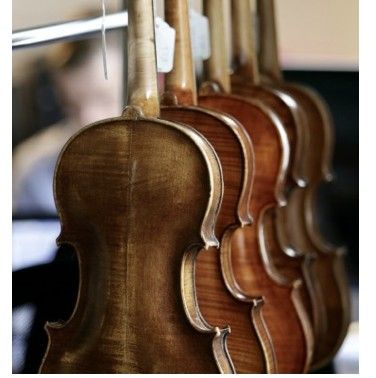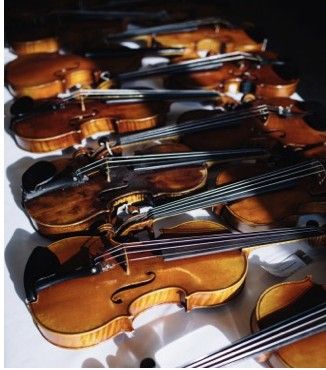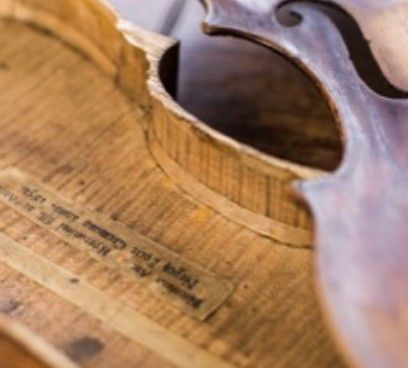Find Your Violin Worth Today
Edward Heron Allen
He resides at 3 Northwick Terrace, N.W. He claims a very warm place all to himself in a dictionary of this sort, not only because he has made one or two fiddles, but also because he is the author of the very popular work, " Violin Making, as it Was and Is," — a book which has done more real service to the art in this country than all other books combined. Mr. Heron- Allen was born in London on the 17th December 1861, and was educated at Harrow. When he left his alma mater in 1878, and became an articled clerk in the firm of which he is now the senior partner, he was already very keen on the violin, having studied under Otto Peiniger at school. He then began with his allowance of pocket-money to collect books on music, but having soon discovered that this was too wide an under-taking, he determined to devote his attention exclusively to books on the violin. The nucleus of his collection were John Bishop's edition of Otto's Treatise, Sandy's and Forster's " History," and a battered copy of Dubourg's book. Then followed Fetis's Stradivari, and the common biography of Paganini. This was a small, but a sure beginning, and to-day his fiddle bookcase is ten feet high by six, and full to overflowing. As long ago as 1893 he refused an offer of £2,000 for his library, made by Mr. P. W. Pickup, the enthusiastic amateur violinist and colliery owner of Blackburn. Mr, Heron-Allen soon found, however, that though there were plenty of theoretical books, histories, and biographies bearing on the violin, the information concerning how to make a fiddle was so meagre as to be practically represented by the symbol x. His office being in Soho (where it has been a good deal over a century), and the articled clerk of a solicitor's office being a proverbially idle creature, he had plenty of time in which to make friends with the fiddle-makers, and the shops of the Hills, old Boulangier, the elder Tubbs, the elder Hart, the elder Chanot, and the Withers Brothers, became his habitual lounges. He determined, if possible, to supply the lack of a practical book on fiddle-making. But though he collected a quantity of disjointed information (many, many, the cigars they smoked together, old Chanot — God rest his soul ! — and he, in the former's back shop), he did not think, even though he was young enough to have implicit and unlimited confidence in himself, that he knew enough to warrant him in writing a book on the subject. On the 4th and 5th of May 1882, Carl Engel's library was sold, and at his sale he got a few more books on the violin, but most of them were bought over his head by Bernard Quaritch. This necessitated his calling upon Mr. Quaritch and negotiating the re-sale to him of the books he wanted. It was then Mr. Heron-Allen and Mr. Quaritch formed the friendship which still exists between them. This seems irrelevant, but it is not. Quaritch seeing that Heron-Allen was so full of youthful enthusiasm about the fiddle, let him have his coveted books at practically the prices he had given for them, and furthermore enjoined him to write a treatise on the violin and deliver it, as his guest, at a meeting of the then recently (1878) founded " Sette of Odd Volumes." This lecture he delivered on Friday, June 2, 1882, and he made the acquaintance on that occasion of Captain Sir Richard Burton and Commander Cameron, with the former of whom he remained most intimate until his (Sir Richard Burton's) death. It was Sir Richard that encouraged him still further to collect the literature of the violin and complete his studies of the instrument itself. The lecture was printed for the author by Mitchell & Hughes in Wardour Street, and became No. 1 of his series of pamphlets on the violin called De Fidiculis Opuscula ; it afterwards formed part of the introduction to "Violin Making." This launched him upon the sea of violin literature on his own account, and after making further investigations in Wardour Street, he decided to get taken on as a casual apprentice in a workshop, and really learn, step by step, the art and mystery of violin-making. The final " push-off " was given by the publishers, Messrs. Ward, Lock & Co., who just at that time projected their monthly magazine called Amateur Work and he undertook to supply them with a series of articles on practical fiddle-making for amateurs, at what then struck him as the magnificent remuneration of 7s. 6d. per page, the copyright and all rights of reprinting the articles in book form to be the absolute property of the publishers, without further payment. Mr. Heron- Allen was most pleasantly young then ! It need hardly be said that Messrs. Ward, Lock have never made him any payment in respect of the many editions they have issued since 1884. Indeed, a few years ago, when the author offered to revise the book for a small fee, they stated that they did not feel justified in incurring the expense ! Mr. Heron-Allen at last made arrangements with old Mr. Chanot that the latter should supply him with wood, at a price, and that he should work at his fiddle whenever he could, paying the sum of 10s. 6d. for every hour he worked in the shop. Chanot made a violin step by step with his pupil, and so did his son Joseph (the first he had made). So it may be said that J. A. Chanot and the subject of this sketch were apprenticed together. Mr. Heron-Allen began his first fiddle, a Strad model on the hollow or "inside" mould, on April 20, 1882, and he took two fiddles, made exactly as described in his book, away finished on September 15, 1883, made, of course, entirely with his own hands. Meanwhile he described every step in his articles in Amateur Work from notes made in the workshop at the time. It is improbable that it ever occurred to Georges Chanot that he was a " chiel " taking notes for publication. If it had, it is not likely that he would have learnt as much as he did of the mysteries of a fiddle-maker's workshop. The two fiddles were made from the best materials procurable. The measurements are those given in " Violin Making, as it Was and Is." They are varnished with fifteen coats of a tender amber-coloured varnish, with a glint of rose in it. This is laid on a coat of bright yellow saffron stain, which gives a speck of fire wherever the oil varnish has chipped or worn. Not that it has chipped much, for even now it is perfectly tender and elastic. The composition of his varnish is as (or nearly as) described in the above-named book. Mr. Heron-Allen is of opinion, however, that no one can give a perfect recipe for varnish ; it is, he says, just like making claret-cup or punch, one begins with a rough formula, and tastes and adds this and that as it seems required, until it is all right. No varnish worth the name, he further maintains, can be made on a set-fast formula — varnishes so composed vary at various seasons and in various climates. It is interesting to note that the Rev. H. R. Haweis appears to hold an identical opinion (see "Old Violins," p. 149). Mr. Heron- Allen's fiddles have matured very rapidly, considering that they are left very thick in wood. The tone is reported to be large and mellow, and of great equality on all the strings. Joachim, Wilhelmj, Johannes Wolff, Simonetti, and a host of other great violinists have played upon the Joseph copy (Mr. Heron-Allen's favourite instrument), and have expressed some astonishment and a great deal of kind admiration at it. Mr. Heron-Allen has ceased to make fiddles, but is keener than ever on Fiddle Lore. Since 1885 he has continued to amass books on the subject, and he is proud to possess a good many works which are not represented in the British Museum, the Bibliotheque Nationale, nor in the Bibliotheque Royale in Brussels. He published a catalogue of them in 1891-94, in two volumes, quarto, under the title of De Fidiculis Bibliographia comprising about 1400 items. For his first book he was sent by the Commissioners of the Inventions and Music Exhibition of 1885 to collect ancient musical instruments, and he received a certificate of merit and a silver medal ; for his Bibliography he was elected Socio Onorario e Benemerito of the Academia di Santa Cecilia in Rome. His further publications have been " Hodges v. Chanot — the History of a Celebrated Case," " Fidiculana," and a book of essays on the violin, "The Letters of de Beriot," "The Seal of Roger Wade," a curious early document upon the Welsh Crwth, and " The Arts and Crafts Book of the Worshipful Guild of Markneukirchen Violin Makers." Mr. Heron-Allen is also the possessor of the largest collection of unpublished autograph letters of celebrated violinists in England. He was fortunate enough to secure nearly all the letters written by violinists to Louis Spohr at his sale some years ago. Mr. Heron-Allen's labels are drawn in pen and ink, and each one differently. The instruments he has made are at his own and at his father's residence. They were not made for sale, and no price is put upon them ; in fact, he would not part with them for any consideration.
Show more Hide textSimilar Makers
Books by Amati
Amati, in collaboration with leading experts, have published a few key books in the field of stringed instruments.
Explore more


